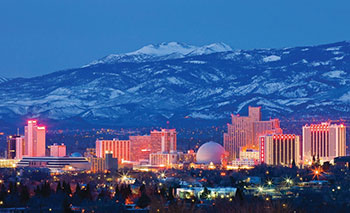28th Annual Loosest Slots Awards
Our report on the highest slot returns during an unprecedented year
By Frank Legato
 The year 2020 was a calamity for businesses of all kinds, but the casino hospitality business took one of the biggest hits from the COVID-19 pandemic and the subsequent Great Shutdown. Casinos in most places were closed from two to three months, while some—in New York, Downtown Las Vegas and elsewhere—remained shuttered much longer.
The year 2020 was a calamity for businesses of all kinds, but the casino hospitality business took one of the biggest hits from the COVID-19 pandemic and the subsequent Great Shutdown. Casinos in most places were closed from two to three months, while some—in New York, Downtown Las Vegas and elsewhere—remained shuttered much longer.
Even after they’ve reopened, the slot floors have operated at severely reduced capacity, normally with at least every other machine deactivated to facilitate social distancing.
All of this affected the planning of this annual issue. Since 1994, the Loosest Slots Awards have been based on 12 months of data. The idea of “loosest slots” started with the monthly publishing of charts in Casino Player showing overall payback percentages offered by casinos. Shortly after Casino Player debuted in 1988, the editors decided to gather all the “hold” data that commercial casinos were required to publicly report—that’s the percentage of wagers kept by the casino—and flip-flop the numbers to show the portion of all wagers that was returned to players as slot winnings, creating the “payback percentage.”
Casino Player published those numbers monthly, as did sister publication Strictly Slots beginning in 1998.
The casinos resisted at first, but eventually used the “Loosest Slots” designation as a badge of honor. The only problem with the monthly charts was that they reported a narrow window of play. There would be months that high-end slot players killed the casinos, resulting in a payback percentage over 100 percent for the months in some high denominations.
Statisticians have found that a game on a casino floor reaches its true payback percentage in two to three months of play. Therefore, with the longest-closed casinos still logging six months of data, the average payback percentages are accurate. (The chart showing our Loosest Slots winners indicates how many months of play led to each average percentage.)
The numbers still boil down to a guide for players to the most generous casinos in the nation.
So, welcome to the 28th annual Loosest Slots Awards. As always, a few editor’s notes before we get to the winners:
First of all, not all casinos are included in this report. We are restricted to reporting on the statistics that are publicly available, and for the most part, that includes all commercial casinos and many of the largest Native American casinos. Because Indian casinos are not subject to required reporting to their state regulatory agencies, many of those casinos—notably, in California—consider the statistics proprietary information, and do not report them publicly. Our apologies if your favorite casino is not included.
Next, we are only able to report the numbers that are reported by the casinos. That is why you will not find denominations broken out in many locations—such as New Jersey, where regulators stopped reporting separate denominations six years ago.
Finally, the way the numbers are reported publicly is the reason video poker paybacks are not broken out in this report. No jurisdiction reports separate numbers for slots and video poker.
However, you’ll find that the casinos with the highest overall paybacks consistently offer the highest-returning pay schedules on video poker.
And The Winners Are…
Reno still rules.
For the 14th year in a row, the loosest slots in the U.S. can be found in Reno, Nevada—home to the Silver Legacy, the Eldorado, the Atlantis, the Grand Sierra and, sadly with its last slot reports, the original Harrah’s, which closed permanently in March 2020 after 82 years.
The casinos of Reno collectively returned 94.53 percent of slot wagers to players last year, topping the nation. However, for the first time in memory, the No. 2 finisher for Loosest Slots is not one of Nevada’s other regions. It is South Dakota, with an average payback total of 93.89 percent.
The normal two-thirds of the Top 3 weren’t far behind, with the “Balance of Clark County”—the Clark County casinos outside of the Las Vegas Strip and Boulder Highway, such as the Orleans, the Red Rock and Green Valley Ranch—returning 93.83 percent of wagers to players, essentially a tie for second place. Right behind that was Mesquite at 93.77 percent.
The Loosest Slots on the East Coast can be found at Hialeah Park & Racing in Florida. Slots have been an important part of the rejuvenation of the historic South Florida racetrack and casino, which returned 93.71 percent of wagers to slot players last year. That return-to-player is nearly two points ahead of second place in the East—Foxwoods in Connecticut at 92.02 percent.
Connecticut casinos, by the way, remain very close in payback percentage, with Mohegan Sun only 0.18 percent behind Foxwoods.
Elsewhere, in Atlantic City, the top two casinos for Loosest Slots have not changed in three years— Harrah’s Resort at 91.8 percent, Borgata at 91.32 percent. Bally’s Atlantic City edged out last year’s third-place winner, Caesars Atlantic City, at 90.88 percent.
In Indiana, Prairie Meadows took the Loosest Slots crown, edging out last year’s winner Grand Falls. In the new Massachusetts market, Encore Boston Harbor (92.19 percent) edged out Plainridge Park and MGM Springfield. In Pennsylvania, Valley Forge Casino (90.57 percent) edged out last year’s winner Parx.
Repeat Loosest Slots Awards were won by Cripple Creek in Colorado (93.19 percent), Harrington Park in Delaware (91.86 percent), Lake Charles in Indiana (90.9 percent) and the Central Region in Mississippi (91.75 percent).
Our congratulations to all the Loosest Slots winners. As we emerge to full capacity when the current pandemic finally ends, our readers surely will remember you.
CLICK HERE to see how your favorite casino did!


